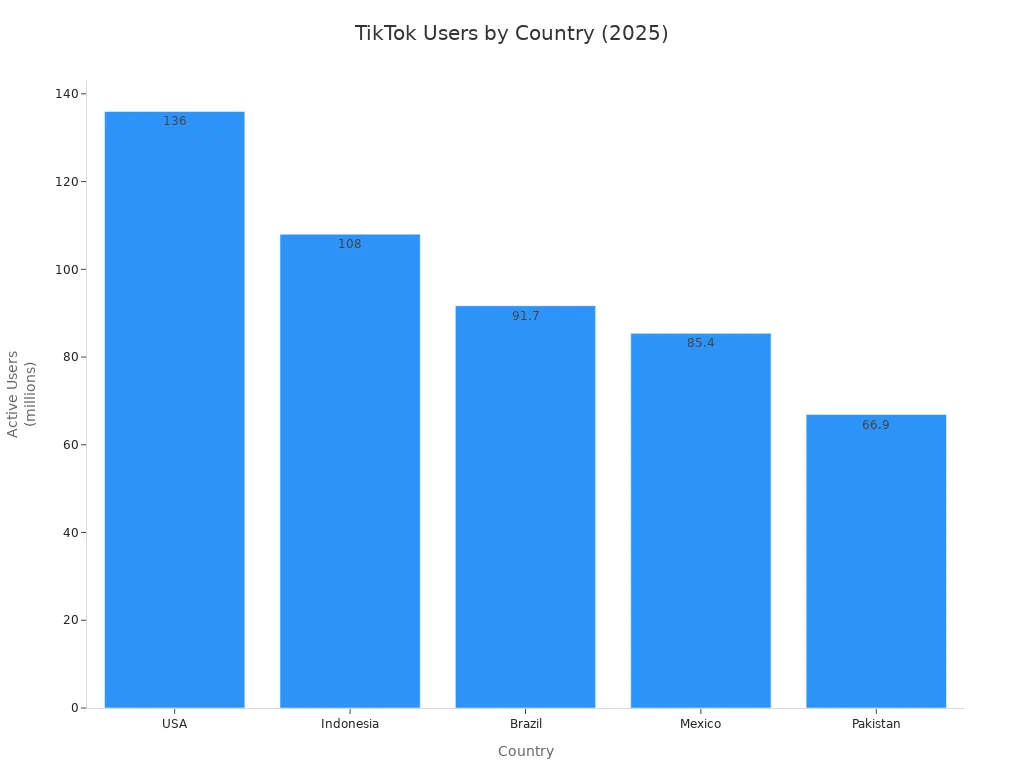Opportunities in the TikTok Mexico Market

The TikTok Mexico Market offers businesses and entrepreneurs a dynamic landscape fueled by remarkable user growth. With a penetration rate of 87.7% among adults and over 85 million users, Mexico ranks among the top five countries for TikTok adoption. The recent launch of TikTok Shop has transformed e-commerce by enabling purchases directly within the app, boosting opportunities for brands and creators. Logistics and cross-border solutions, such as JUSDA in North America, play a crucial role in helping sellers navigate this fast-moving environment.
Key Takeaways
TikTok Mexico has over 85 million active users, mostly young adults, making it a top market for digital engagement and e-commerce growth.
TikTok Shop allows sellers to showcase products through videos and live streams, offering a smooth shopping experience inside the app.
Popular product categories include beauty, fashion, home goods, wellness, and pet supplies, with strong demand from younger shoppers.
Live commerce and influencer marketing drive high engagement and sales by creating authentic, real-time connections with Mexican audiences.
Efficient logistics and compliance with local regulations are essential; partners like JUSDA help sellers manage shipping, customs, and taxes.
TikTok Mexico Market Overview

User Trends
The TikTok Mexico Market stands out as one of the fastest-growing digital communities in Latin America. In 2025, Mexico ranks fourth globally for active TikTok users, with 85.4 million people engaging on the platform. The table below shows how Mexico compares to other top countries:
Rank | Country | Active TikTok Users (2025) |
|---|---|---|
1 | USA | 136 million |
2 | Indonesia | 108 million |
3 | Brazil | 91.7 million |
4 | Mexico | 85.4 million |
5 | Pakistan | 66.9 million |

TikTok Mexico Market users are mostly young adults. Gen Z and millennials make up the majority, with 41% aged 18-24 and 33.9% aged 25-34. The platform’s advertising reach grew by 15.1% in one year, now covering 91.7% of adults aged 18 and above. Engagement rates are high, averaging 18.3%, which is above the global average. Most influencers in Mexico are still building their audiences, but the market shows strong potential for growth and monetization.
E-commerce Growth
Mexico’s e-commerce sector is booming. In 2024, the market reached MX$789.7 billion, making up 14.8% of all retail sales. Mobile commerce leads the way, with 80% of online transactions happening on smartphones. The TikTok Mexico Market benefits from this trend, as users discover and buy products directly through the app.
Mexico has 67.2 million digital buyers.
Major platforms like Mercado Libre and Amazon Mexico see rapid growth, with 120 million and 105 million monthly visits, respectively.
Payment methods are changing. Debit and credit cards account for 55% of transactions, while digital wallets and cash-based options like OXXO Pay remain popular.
Social media drives product discovery. 27.6% of young Mexicans use TikTok for shopping inspiration.
Live shopping and phygital experiences are rising, with TikTok Shop expected to generate $7.4 billion in Latin America by 2025.
The TikTok Mexico Market attracts younger shoppers, especially those interested in beauty, personal care, and electronics. The average order value on TikTok Shop is higher than traditional platforms, and conversion rates reach nearly 6%. As mobile commerce grows, TikTok Shop continues to shape new buying habits and expand its influence in Mexico’s digital economy.
TikTok Shop Essentials

Features
TikTok Shop in Mexico brings e-commerce directly into the TikTok app, creating a seamless shopping experience for both sellers and buyers. Sellers can display products through short videos, live streams, and a dedicated product catalog tab on their profiles. This approach allows brands to engage with audiences in real time, answer questions, and offer exclusive promotions. The platform supports a wide range of product categories, including fashion, beauty, home goods, and electronics.
Key features include:
Integration of online stores and payment systems within the TikTok app, making purchases quick and secure.
Live shopping tools that let sellers showcase products and interact with viewers instantly.
Direct product links embedded in videos, so users can buy without leaving the app.
Real-time analytics to track sales performance and optimize marketing strategies.
Flexible logistics options, including seller-managed shipping or Fulfilled by TikTok for warehousing and delivery.
In-app marketing tools such as TikTok Ads Manager, Spark Ads, and discount codes to boost visibility.
Collaboration opportunities with content creators and TikTok Shop Affiliates for influencer-driven sales.
These features help sellers reach digitally native consumers and drive e-commerce growth in Mexico.
Seller Requirements
To join TikTok Shop in Mexico, sellers must meet specific requirements and comply with local regulations. The process ensures a safe and trustworthy marketplace for all users.
Requirement Category | Details |
|---|---|
Business Documentation | Legal company name, Date of incorporation, CFS file, RFC number (Mexican Tax ID), Principal business address |
Representative Documentation | Official identification, Full legal name, Date of birth, Nationality, Residential address (optional) |
Tax Compliance | Obtain Mexican RFC, VAT optimization, Tax reporting and invoice compliance |
Bank Account | Business bank account matching registration details |
TikTok Shop Registration | Seller verification, Shop name guidelines adherence |
Additional Support | Logistics integration, Growth strategies including viral trends and creator collaborations |
Tip: Sellers should keep all documents up to date and follow TikTok Shop’s policies to avoid account issues. Regular audits may occur, and violations can lead to penalties or removal from the platform.
Key Opportunities
Top Categories
The TikTok Mexico Market presents several high-potential product categories for sellers. Brands that focus on trending items can capture rapid sales growth and build strong customer loyalty. The following table highlights categories currently experiencing the fastest expansion:
Product Category | Examples of Trending Products and Features |
|---|---|
Beauty & Skincare | Bakuchiol serum, microneedle patches, glycolic acid toner |
Fashion | Barrel-fit jeans, yoga pants, mesh ballet flats |
Home & Kitchen | Tumble rugs, waterfall kitchen sinks, cleaning supplies |
Wellness | Mushroom chocolate, probiotic soda, caffeine gummies |
Pets | Treat-dispensing dog games, salmon bites (dog treats) |
Beauty and skincare remain the largest category, with Mexican consumers showing strong interest in innovative products and viral beauty routines. Fashion items such as yoga pants and mesh ballet flats attract Gen Z and millennial shoppers who value both style and comfort. Home and kitchen products, including unique rugs and modern sinks, appeal to families and young professionals seeking practical upgrades. Wellness products and pet supplies also see rising demand, driven by health-conscious buyers and pet owners who follow TikTok trends.
Sellers who tailor their offerings to local preferences and seasonal events, such as Christmas or religious holidays, can maximize their reach. Early entrants like Meoky in home goods and Chen Rongyan in women’s apparel have demonstrated that understanding local tastes and inventory needs leads to rapid sellouts and repeat customers.
Live Commerce
Live commerce has become a powerful sales driver in the TikTok Mexico Market. Mexican users spend an average of 95 minutes daily on TikTok, with live streams attracting higher engagement than in other regions. Sellers use live shopping events to showcase products, answer questions, and offer exclusive deals in real time.
Tip: Brands should book Spanish-speaking hosts and plan live events around local holidays or trending topics to boost participation.
Live commerce allows sellers to demonstrate product features and build trust with viewers. For example, Meoky’s team sold out three containers of drinkware in one month by leveraging live streams and influencer partnerships. Mexican audiences interact with live hosts through comments and tips, doubling the engagement rates seen in the U.S. This format creates urgency and excitement, encouraging viewers to make quick purchase decisions.
Influencer Marketing
Influencer marketing plays a central role in driving sales and brand awareness on TikTok Shop Mexico. Mexican influencers connect with audiences using humor, regional dialects, and Spanglish, making content relatable and authentic. They build trust through honest reviews, storytelling, and product demonstrations.
Over 60% have made purchases based on influencer recommendations.
Micro-influencers achieve higher engagement rates, making them ideal for targeted campaigns.
Brands collaborate with influencers to reach younger, trend-sensitive shoppers. A beauty brand in Querétaro partnered with micro-influencers and saw a 600% spike in traffic, selling out inventory within two days. A taco chain in Mexico City worked with local food creators, tripling foot traffic over a weekend through viral TikTok reels.
TikTok’s algorithm favors short, engaging videos, helping influencers reach large audiences quickly. Tools like Influencer Hero support brands in discovering and managing influencer campaigns efficiently. By leveraging influencer partnerships, sellers can boost brand visibility and drive viral marketing success in the TikTok Mexico Market.
Logistics & Cross-Border Solutions
JUSDA in North America
Efficient logistics form the backbone of success for sellers in the TikTok Mexico Market. Mexico’s geography includes urban centers, rural towns, and remote regions. This diversity complicates product shipping, especially for large or fast-delivery items. Transportation infrastructure shortages increase logistics costs and delivery times. Customs clearance and tariff procedures add more hurdles for international e-commerce. Competitors like Amazon and Mercado Libre invest heavily in warehousing and distribution to overcome these challenges. TikTok Shop must develop an efficient and fast logistics system to stay competitive.
JUSDA in North America stands out as a strategic logistics partner for cross-border trade. The company specializes in industries such as electronics, automotive, and medical devices. JUSDA offers a comprehensive carrier network for cross-border transport between the U.S. and Mexico. Their quote management system provides transparency and compliance for every shipment. JUSDA’s expertise in handling hazardous materials, including lithium batteries, ensures strict adherence to safety regulations. The company supports regional expansion, focusing on the U.S. East Coast and the US-Mexico border. JUSDA also invests in customer relationship building and uses data tools for market analysis. These features help sellers streamline operations and reduce costs.
Note: As e-commerce grows in Mexico, efficient logistics solutions can reduce shipping costs by up to 40%. This makes operations more cost-effective and streamlined for TikTok Shop sellers.
JUSDA’s tailored solutions address the unique needs of businesses entering the TikTok Mexico Market. Their services help sellers manage customs, optimize inventory, and ensure reliable last-mile delivery. By partnering with JUSDA, sellers gain a competitive edge in a rapidly expanding market.
Overcoming Challenges
Cross-border e-commerce in Mexico faces several regulatory and compliance issues. Sellers must adapt to new rules and requirements to succeed.
Mexico enforces GDPR-like data protection measures for consumers.
Businesses must store sensitive consumer data on local servers to comply with data localization laws.
Companies need strong cybersecurity measures to maintain customer trust.
Mexico introduced VAT collection on imported goods, requiring updates to tax systems.
Digital platforms like Amazon and Mercado Libre must collect taxes for sellers.
Detailed documentation, including invoices and proof of compliance, is required for customs clearance.
Mexico prohibits foreign entities from registering as Foreign Importer of Record. U.S. companies need a local importer of record.
Non-Tariff Barriers (NTBs), such as Official Mexican Standards (NOMs), require product labeling and safety certifications.
Sellers must have a valid Mexican Tax ID (RFC) to avoid tax withholdings.
Compliance with NTBs must be secured before shipment to avoid customs delays.
JUSDA helps sellers navigate these challenges by providing regulatory guidance and compliance support. Their team ensures shipments meet all documentation and safety standards. JUSDA’s risk management approach covers hazardous materials and complex customs requirements.
Recent tariff changes have reshaped cross-border logistics in Mexico. The removal of the Section 321 de minimis exemption in the U.S. increased import costs and customs scrutiny. Mexico imposed tariffs of 15%–35% on imported textile inputs and apparel, especially from China. Amendments to the IMMEX program prevent misuse for e-commerce fulfillment, adding complexity to logistics. New taxes on low-value shipments and stricter customs controls have made returns more expensive and delivery times less predictable. Companies like Temu have shifted from direct shipments to local warehousing to reduce tariff exposure.
Tariffs on Mexican goods increase sourcing and fulfillment costs.
Supply chains face disruptions and delays, especially for just-in-time inventory models.
Increased shipping costs and customs delays complicate cross-border logistics.
Customs clearance is unpredictable, requiring detailed documentation and extra lead time.
Mexico’s infrastructure limitations affect last-mile delivery, prompting companies to maintain multiple distribution points.
JUSDA’s logistics solutions help sellers adapt to these changes. Their network supports nearshoring strategies, which optimize costs and improve logistics efficiency. By leveraging JUSDA’s expertise, sellers can overcome regulatory, tariff, and infrastructure risks in the TikTok Mexico Market.
Getting Started
Registration Steps
New sellers can join TikTok Shop Mexico by following a clear registration process. The steps below outline how to set up an account and meet all legal requirements:
Choose the account type: Individual, Individually-owned Business, or Corporation.
Gather the necessary documents:
Individuals need a government-issued ID and a personal bank account.
Individually-owned businesses require a business license, tax ID, and business bank account.
Corporations must provide corporate registration documents, tax ID, and a corporate bank account.
Ensure the bank account name matches the ID or business registration.
Prepare valid contact details, including an email address and phone number.
Register through the TikTok Seller Center.
Confirm the account type during signup.
Enter business or personal information as required.
Upload all documents clearly and completely.
Link the payout bank account.
Set a return address for product returns.
Submit the application for review.
Wait for approval, which usually takes a few business days.
Once approved, start listing products and managing the storefront.
Tip: Sellers must comply with Mexican regulations. This includes formal business incorporation, obtaining a Mexican Tax ID (RFC), and appointing a legal representative with a government-issued ID and RFC number. Accurate documentation and adherence to TikTok Shop’s product guidelines are essential for a smooth setup.
Content Strategy
Successful sellers in Mexico use content that feels authentic, entertaining, and community-focused. High-quality user-generated content (UGC) builds trust and encourages shoppers to buy. TikTok challenges related to products boost engagement and generate fresh UGC. Live shopping streams allow sellers to showcase products, answer questions, and offer exclusive deals in real time.
Localization is critical. All content should use Mexican Spanish, including local slang and references to cultural events like Día de Muertos. Sellers benefit from using local hashtags and engaging with comments to foster community. Adapting visuals and language to Mexican preferences increases reach and builds loyalty. Consistent interaction and localized promotions help sellers stand out and grow their presence on TikTok Shop Mexico.
Risks & Considerations
Market Entry
Entering the TikTok Shop Mexico market brings both opportunity and risk. Sellers face a landscape shaped by rapid regulatory changes and rising tariffs. U.S. tariffs now target imports and manufacturing, especially from China. Duty-free import exemptions have tightened, making it harder for brands shipping low-cost goods. Brands that rely on Chinese manufacturing see increased costs and more complex supply chains. The tariff environment forces brands to change sourcing and fulfillment strategies quickly. These disruptions create higher barriers for new entrants to platforms like TikTok Shop Mexico.
Mexico has imposed a 35% tariff on finished textile imports from countries without free trade agreements, such as China. This policy ends the Section 321 program for apparel imports and encourages domestic manufacturing. The tariff remains in place until April 2026, so brands must rethink supply chain strategies. Sellers should expect a shift toward sourcing from Mexican manufacturers or countries with trade agreements. These changes increase operational costs and make market entry more challenging for sellers who depend on low-cost imports.
Sellers who plan ahead and build strong local capabilities can reduce risk and improve their chances of success in Mexico’s evolving e-commerce market.
Compliance
Sellers must pay close attention to compliance and inventory planning. Mexican e-commerce sales are mostly mobile-driven, so sellers should optimize their stores for mobile platforms. Popular payment methods include debit cards, bank deposits, electronic transfers, and cash on delivery. Integrating these options helps reduce payment friction and builds trust with buyers.
A multichannel presence is essential. Mexican consumers shop on marketplaces like Mercado Libre and Amazon, and use social networks such as TikTok, WhatsApp, Facebook, and Instagram. Sellers should leverage these platforms alongside their own websites. Logistics challenges remain significant. Many small businesses lack real-time inventory and shipping integration, which leads to delays and stockouts. Sellers should adopt inventory management tools and coordinate shipping closely to improve customer satisfaction.
Offer free or discounted shipping to stay competitive.
Communicate flexible return policies to build customer loyalty.
Invest in digital advertising to increase brand recognition and reduce the risk of losing customers.
Sellers who adapt to local consumer preferences and maintain strong compliance practices can minimize risk and build lasting success in the TikTok Shop Mexico market.
The TikTok Mexico Market offers unmatched growth for brands ready to act now.
Opportunity Area | Why It Matters |
|---|---|
Young, engaged shoppers | Over 60% of the population is under 35 and active on social media. |
Fast e-commerce growth | Double-digit annual growth and rising mobile payments drive new sales. |
Unique shopping tools | Live video, influencer marketing, and easy checkout boost consumer trust. |
Strong logistics partners like JUSDA in North America help sellers overcome cross-border challenges with reliable shipping and compliance support. Businesses that use TikTok Shop’s new features and trends can lead the next wave of e-commerce in Mexico. Now is the time to explore, adapt, and grow.
FAQ
What are the main benefits of using JUSDA for TikTok Shop Mexico sellers?
JUSDA provides reliable cross-border logistics, transparent quote management, and specialized handling for hazardous materials. Sellers gain faster customs clearance and improved delivery times. JUSDA’s expertise helps businesses reduce risks and manage compliance in the Mexican market.
How can sellers ensure compliance with Mexican e-commerce regulations?
Sellers must register a legal business, obtain a Mexican Tax ID (RFC), and follow product labeling and safety standards. They should keep all documents updated. JUSDA offers guidance on regulatory requirements and helps sellers avoid common compliance mistakes.
Which product categories perform best on TikTok Shop Mexico?
Beauty, home goods, mother and baby, and Gen Z-focused products lead in sales. Sellers who localize products and marketing for Mexican consumers see higher engagement and repeat purchases.
What content strategies work best for TikTok Shop Mexico?
Sellers should use Mexican Spanish, local slang, and references to cultural events. High-quality videos, live streams, and user-generated content build trust. Engaging with comments and using trending hashtags increases visibility.
How do recent tariff changes affect cross-border sellers?
Mexico raised tariffs on many imported goods, especially from China. Sellers face higher costs and stricter customs checks. JUSDA helps businesses adapt by optimizing shipping routes and providing up-to-date information on tariff changes.
See Also
Revealing How Technology Shapes Current Market Patterns
Achieving Cross-Border Trade Success Through JUSDA Strategies
JUSDA Influences Market Trends By Meeting Customer Needs
Five Key Steps To Winning Supply Chains Via Trends
Exploring New Supplier Partnerships In Global E-Commerce Markets
